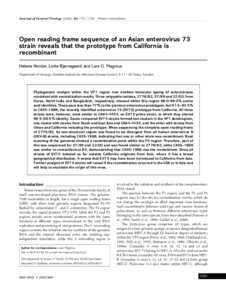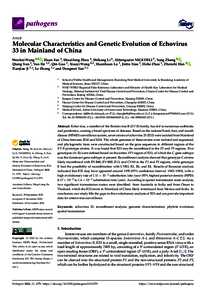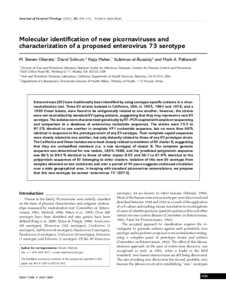Document
Open reading frame sequence of an Asian enterovirus 73 strain reveals that the prototype from California is recombinant.
Identifier
DOI: 10.1099/0022-1317-83-7-1721
Source
Journal of General Virology. v. 83, 7, P. 1721-1728
Contributors
Bjerregaard, Lotte., Author
Magnius, Lars O., Author
Country
United Kingdom.
City
London.
Publisher
Society for General Microbiology.
Gregorian
2002-07-01
Language
English
English abstract
Phylogenetic analysis within the VP1 region now enables molecular typing of enteroviruses consistent with neutralization results. Three untypable isolates, 2776/82, 57/99 and 22/00, from Korea, North India and Bangladesh, respectively, showed within this region 98.0-99.0% amino acid identities. These were less than 77% to the previous enterovirus prototypes, but 91.5-92.5% to CA55-1988, the recently identified enterovirus 73 (EV73) prototype from California. All three strains were, however, most similar to CA64-4454, an EV73 prime strain, to which they shared 96.5-98.5% identity. Seven compared EV73 strains formed two clusters in the VP1 dendrogram, one cluster with strains from South and East Asia and CA64-4454, and the other with strains from Oman and California including the prototype. When sequencing the complete open reading frame of 2776/82, its non-structural region was found to be divergent from all human enterovirus B (HEV-B) strains, including CA55-1988, indicating that one or other strain was recombinant. Boot scanning of the genomes showed a recombination point within the P2 region. Therefore, part of this was sequenced for 57/99 and 22/00 and was found similar to 2776/82, while CA55-1988 was similar to coxsackievirus B3, demonstrating that CA55-1988 was the recombinant. Since all strains of EV73 isolated so far outside California originate from Asia, where it has a broad geographical distribution, it seems that EV73 may have been introduced to California from Asia. Further analysis of EV73 strains will reveal if the recombination occurred in the USA or in Asia and will help to elucidate the origin of this virus.
ISSN
0022-1317
Category
Journal articles



